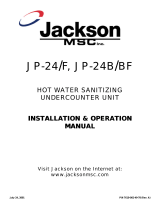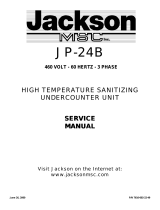PREPARATION: Before proceeding with the start-up of the unit,
verify the following:
1. The pan strainer and pump suction strainer are in
place and are clean.
2. The overflow tube and o-ring are installed.
3. That the wash and rinse arms are screwed securely
into place and that their endcaps are tight. The wash
and rinse arms should rotate freely.
POWER UP: To energize the unit, turn on the power at the service
breaker. The voltage should have been previously verified as
being correct. If not, the voltage will have to be verified.
FILLING THE WASH TUB: Ensure that the delime switch is in the
NORMAL position, and place the power switch into the ON posi-
tion. The Tempstar should fill automatically and shut off when the
appropriate level is reached (just below the pan strainer). Verify
that the drain stopper is preventing the wash tub water from leak-
ing excessively. There may be some slight leakage from the drain
hole. Verify that there are no other leaks on the unit before pro-
ceeding any further. The wash tub must be completely filled before
operating the wash pump to prevent damage to the component.
Once the wash tub is filled, the unit is ready for operation.
FILLING THE WASH TUB (TEMPSTAR HH/HH NB): For the ini-
tial fill, ensure that the cycle selection switch is in the “AUTO”
(automatic) position, and place the power switch in the “ON” posi-
tion. The unit will fill automatically and run through a rinse cycle.
Open the doors and verify that the water level is correct.
Hereafter, the water level is controlled by the overflow tube. Verify
that the drain stopper is preventing the wash tub water from drain-
ing excessively. There may be some slight leakage from the drain
hole. Verify that there are no other leaks on the unit before pro-
ceeding any further. The wash tub must be completely filled before
operating the wash pump to prevent damage to the component.
Once the wash tub is filled, the unit is ready for operation.
WARE PREPARATION: Proper preparation of ware will help
ensure good results and less re-washes. If not done properly,
ware may not come out clean and the efficiency of the dishma-
chine will be reduced. It is important to remember that a dishma-
chine is not a garbage disposal and that simply throwing
unscraped dishes into the machine simply defeats the purpose
altogether of washing the ware. Scraps should be removed from
ware prior to being loaded into a rack. Pre-rinsing and pre-soak-
ing are good ideas, especially for silverware and casserole dish-
es. Place cups and glasses upside down in racks so that they do
not hold water during the cycle. The dishmachine is meant not
only to clean, but to sanitize as well, to destroy all of the bacteria
that could be harmful to human beings. In order to do this, ware
must be properly prepared prior to being placed in the machine.
DAILY MACHINE PREPARATION: Refer to the section entitled
“PREPARATION” at the top of this page and follow the instructions
there. Afterwards, check that all of the chemical levels are correct
and/or that there is plenty of detergent available for the expected
workload.
WARM-UP CYCLES: For a typical daily start-up, it may be nec-
essary to run the machine through 3 cycles to ensure that all of the
cold water is out of the system and to verify that the unit is oper-
ating correctly. To cycle the machine, ensure that the power is on
and that the tub has filled to the correct level. Lift the doors and
the cycle light will illuminate. When the light goes out, close the
doors, the unit will start, run through the cycle, and shut off auto-
matically. Repeat this two more times. The unit should now be
ready to proceed with the washing of ware.
WASHING A RACK OF WARE: To wash a rack, open the doors
completely (being careful for hot water that may drip from the
doors) and slide the rack into the unit. Close the doors and the unit
will start automatically. Once the cycle is completed, open the
door (again watching for the dripping hot water) and remove the
rack of clean ware. Replace with a rack of soiled ware and close
the doors. The process will then repeat itself.
OPERATIONAL INSPECTION: Based upon usage, the pan
strainer may become clogged with soil and debris as the workday
progresses. Operators should regularly inspect the pan strainer to
ensure it has not become clogged. If the strainer does, it will
reduce the washing capability of the machine. Instruct operators
to clean out the pan strainer at regular intervals or as required by
work load.
SHUTDOWN AND CLEANING: At the end of the workday, close
the doors. When the unit completes the cycle, turn the power
switch to the OFF position and open the doors. Remove and clean
the pan strainer. Remove the drain stopper from the tub and allow
the tub to drain (NOTE: the wash tank water will be hot so caution
is advised). Once the wash tub is drained, remove the pump suc-
tion strainer. Remove soil and debris from the strainer and set to
the side. Unscrew the wash and rinse arms from their manifolds.
Remove the endcaps and flush the arms with water. Use a brush
to clean out the inside of the arms. If the nozzles appear to be
clogged, use a toothpick to remove the obstruction. Wipe the
inside of the unit out, removing all soil and scraps. Reassembly
the wash and rinse arms and replace them in the unit. The arms
only need to be hand tight, do not use tools to tighten them down.
Reinstall the drain stopper and strainers and close the doors.
WATER CONSUMPTION ISSUES AND EFFICIENCY: The
Tempstar HH provides you, the customer, with the ability to con-
trol the hourly rack capacity of the machine. Extending the wash
cycle to wash severely soiled ware, such as mixing bowls, does
not increase the machine’s water consumption. However, select-
ing a longer time cycle does lower the amount of dishes the
machine will be able to wash per hour. It is important for operators
to select the correct wash cycle depending on the amount of
washing required. Not every rack of dishes requires the machine
to be set on the longest wash cycle!
Using good prescrapping procedures and observing the results of
individual racks of ware, operators will soon gain the experience
and knowledge required to ensure that the Tempstar HH operates
at peak efficiency for your needs.
Water hardness and detergent usage will also effect the results of
the Tempstar HH. This manual provides a page on Detergent
Control. It is recommended that owners and operators take the
time to carefully review this section in order to ensure that every-
thing is done to make sure the Tempstar HH operates at peak per-
formance!
OPERATION INSTRUCTIONS
5




























